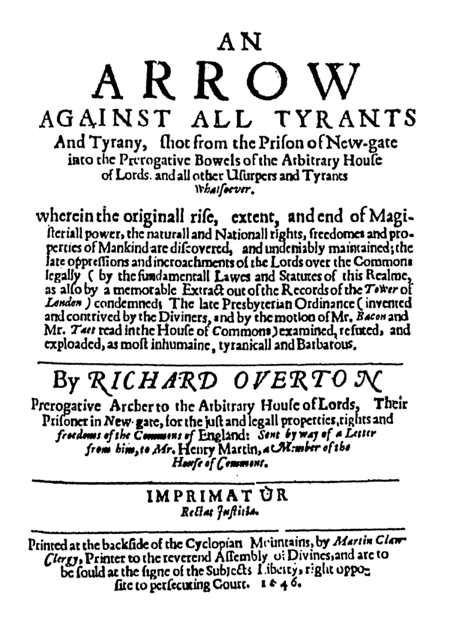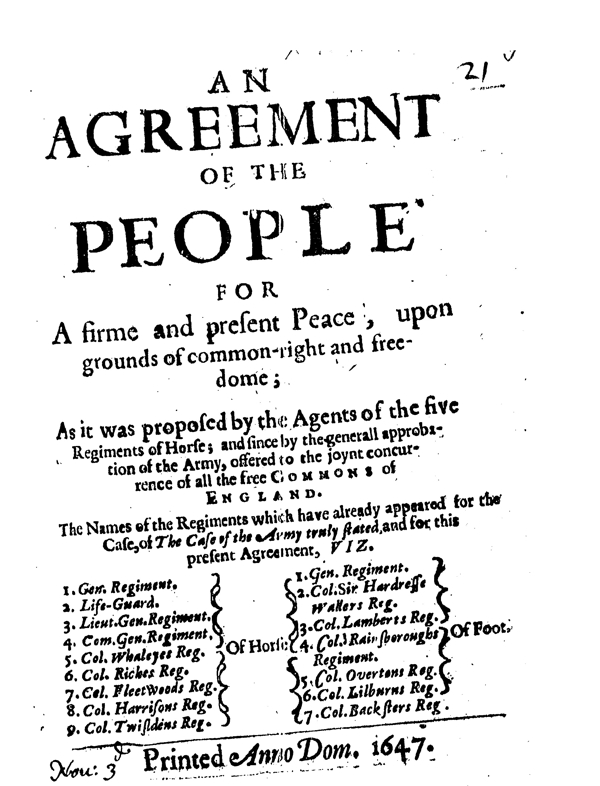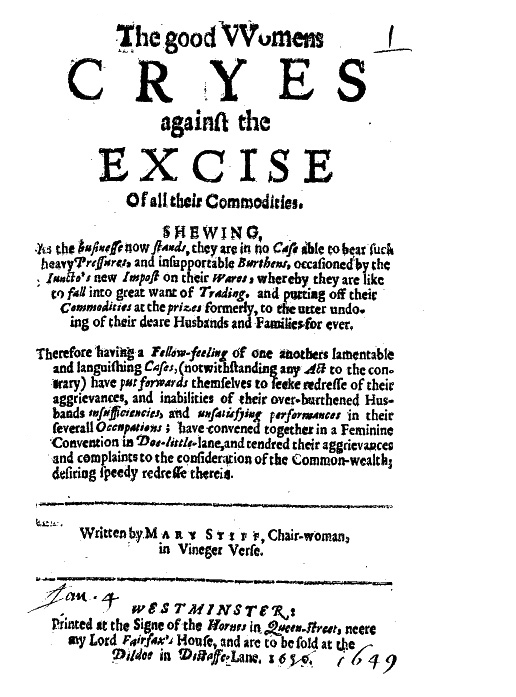In the course of putting together a multi-volume collection of over 300 Leveller Tracts I came across some very interesting title pages which used typography and occasionally woodcuts to add graphical force to the political and economic arguments being made by the authors. The pamphlets were published in their thousands during the 1640s and 1650s – the London bookseller George Thomason collected 23,000 of them over a period of twenty years and these comprise a major collection which is held by the British Library.
One of my favourites is this one depicting John Lillburne in prison. I think of it as a 17th century attempt at “photoshopping” an image – here the prison bars have been added over an image of him dressed in quite formal clothes.
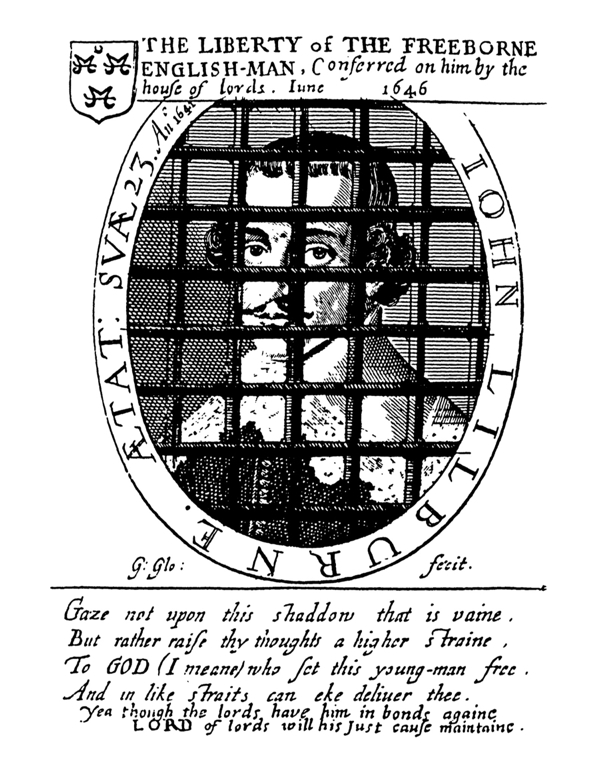
“The Liberty of the Freeborne English-Man, Conferred on him by the house of lords. June 1646.“ The medallion is surrounded by the words “John lilburne. At the age of 23. The Year 1641.” Made by G. Glo.
Beneath is a poem which states:
Gaze not upon this shaddow that is vaine,
But rather raise thy thoughts a higher straine,
To GOD (I meane) who set this young man free,
And in like straits, can eke (also) deliver thee.
Yea though the lords have him in bonds againe
LORD of lords will his just cause maintaine.
The tracts were published by dissidents who did not have much money to publish expensively produced material and so they were printed on cheap paper (which deteriorated quickly and made microfilming later very difficult), using printers who were often sloppy in their typesetting (which only added to the problems for the modern reader of anarchic 17th century spelling and punctuation), and any illustrations they used had to be cheaply done as well.
I have put online a sample of some of the main kinds of illustrations and decorations used in the pamphlet literature of the 1640s, such as the use of decorative borders, large fonts for emphasis, the sculpting of the type into interesting shapes, and the use of crude illustrations and even cartoons of key figures.
For example, some of my favourites include the following:
Anon., A Dialogue betwixt a Horse of Warre, and a Mill-Horse; Wherein the content and safety of an humble and painfull life, is preferred above all the Noyse, the Tumults, and Trophies of the Warre. Full of harmelesse Mirth, and variety. (2 January, 1644).
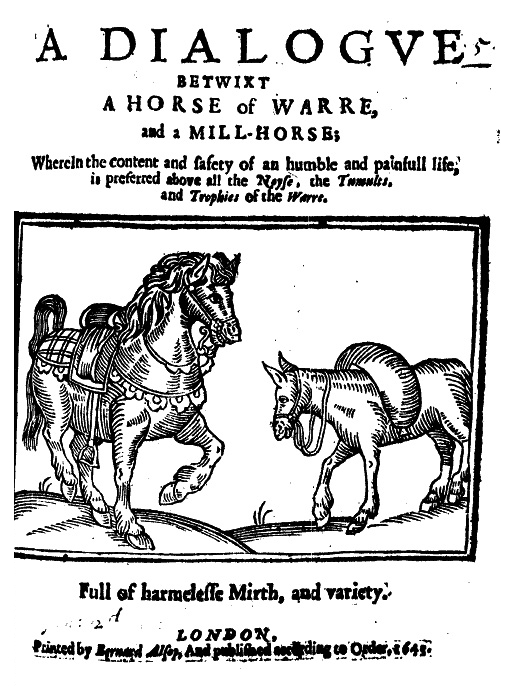
This is one of the more charming pamphlets in the collection. The title page shows a woodcut of two horses, one a large and aggressive looking “horse of war” (no doubt used by soldiers in both the King’s and the Parliament’s armies), and a smaller work horse which was used to turn a mill wheel to grind flour. In the pamphlet the two horses have a conversation about the merits of the work they have to do and in classic fashion the argument is made that the work of the war horse is destructive of both life and property, while the work of the mill horse is productive economic activity which benefits ordinary people. The typesetter has used a very different font for the dialog of each horse throughout the pamphlet (which actually makes it quite hard to read). Note also the war horse on the left is in a dominant position in the picture (higher and larger, with its head held high) while the work horse on the right is lower with its head slightly bowed.
Another is John Taylor, The World turned upside down: OR, A briefe description of the ridiculous Fashions of these distracted Times. By T. I. a well-willer to King, Parliament and Kingdom. (28 January, 1647).
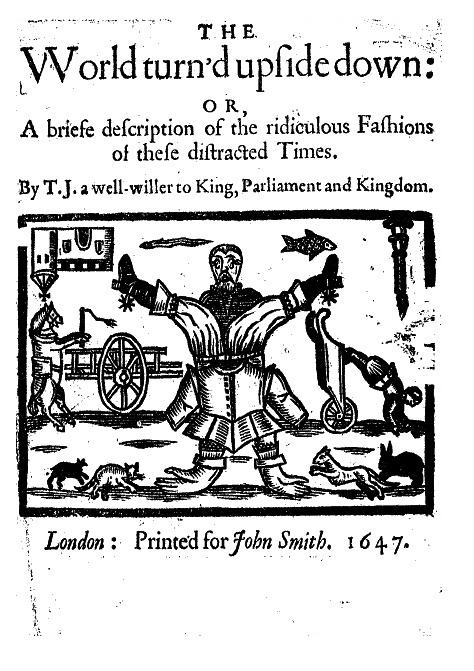
For some people the civil wars, revolution, and then execution of King Charles, turned the world up-side down. Here we have a depiction of what an “up-side down world” might look like. There are churches in the sky, fish flying in the sky, rabbits and rats chasing cats, a man pushed by a wheel barrow and a cart by a horse. In the center there is a man standing on his hands, waving his legs like hands, and his head coming out of his groin. This is the physical equivalent of what the Leveller movement wanted to do politically to England.
Richard Overton wrote a series of pamphlets taking on the voice of “Martin Mar-Priest” , “mar” meaning scarred or disfigured, at least in the eyes of the intolerant Presbyterians whom Overton was attacking. This one is called:
[Overton or Lilburne], A Reall Persecution or, The Foundation of a general Toleration, Displaied and Portrayed by a proper Emblem, and adorned with the same Flowers wherewith the Scoffers of this last age have strowed their Libellous Pamphlets. Collected out of several books of the Sectaries to discover to world their wicked and abusive language against godly Presbyterian Ministers. (13 February, 1647).
It is in the form of a broad-sheet which contains this amusing illustration:

Title:”The Picture of an English Persecutor or, a Foole Ridden-slave) : Presbeterian Sectary”
The Rider’s Speech Bubble: I should ??
The Ridden’s Speech Bubble: My cursed speeches against Presbetry declares unto the world my foolery.
Page in Book: Martin’s Eccho ?? ?? Martin ?? Mar- Preist
Caption below cartoon: For opposing Authority, Reviling the Assembly, Slandering the Governmnet by Presbytry and disturbing the ministers at the time of their publique exersis by giveing up bills in mockery calling the ministers preistsrideing slaves, horse leeches Cormorants gorbellyd Idoll consistory of devills etc : hath not this discoverd Ishmaels carnell Spirits persecuting godly Isaaks.
This pamphlet is in the form of a broad-sheet which lists the supposed crimes committed and the criticisms made by the opponents of tithes. The sheet includes an illustration of a tithe-paying “slave” being ridden by a Presbyterian who is mockingly described as “holy humble gentle”. The person being ridden has the ears of a donkey and is possibly Martin Mar-Priest or one of his supporters as he has in his hands Overton’s pamphlet “Martin’s Eccho”. His speech bubble contains the words “My cursed speeches against Presbetry declares unto the world my foolery”. The Presbyterian seems to be wearing a fool’s cap (so he is the fool not the person being ridden) and the words in his speech bubble are unfortunately illegible.
Interestingly Overton compares the Ordinance giving only state sanctioned priests the right to run churches and provide religious services to the monopoly given to some politically well-connected individuals to produce soap: “59. The Ordinance permitting none to Preach but such as are Ordained, is a Patten of the Spirit worse then the Monopoly of Soap.” In another phrase he tellingly describes the state-privileged religion of the Presbyterians as “56. Their Religion moves upon the wheel of the State”, who expect the people to willingly submit to being ridden by “a Tithe divouring Priest” and (1.) “stand still gaping with your mouths open, and quietly bow down your backs whilst you are bridled and sadled, and let the holy humble gentle Presbyterians get up and ride” all the way “to the Devil” (2.).

